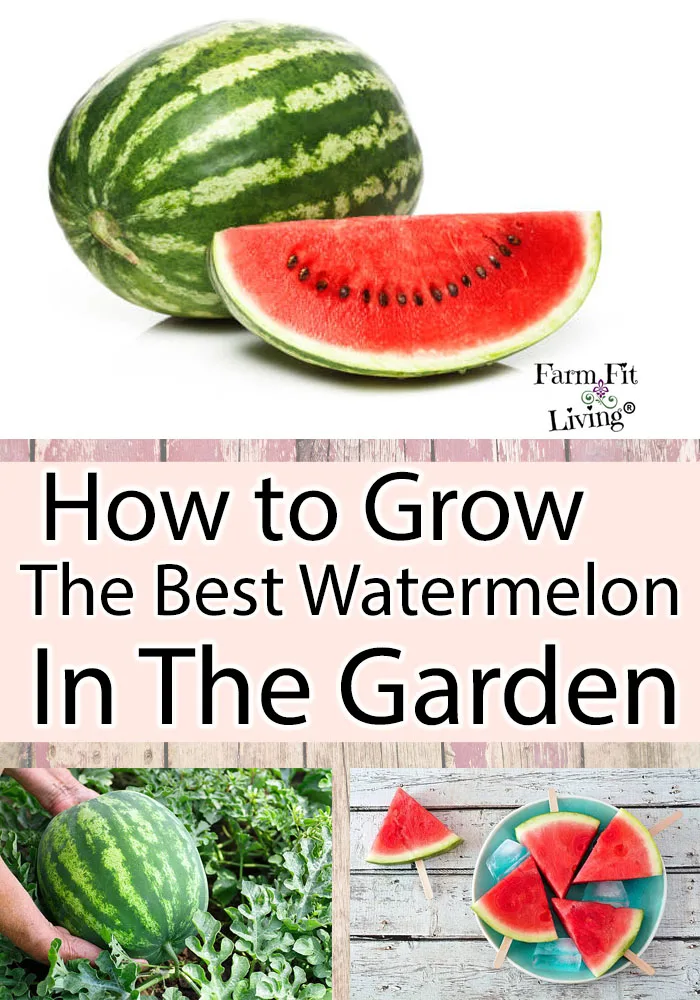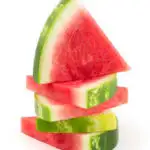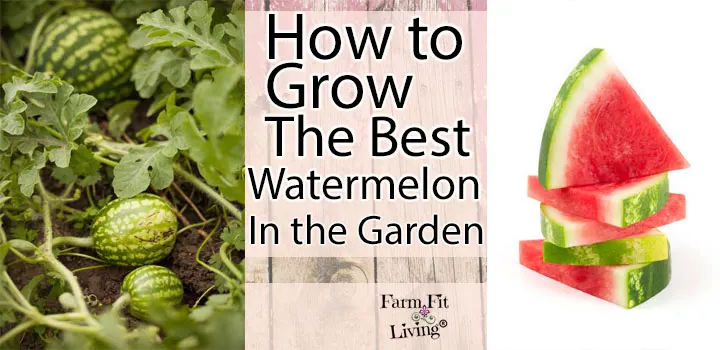Wish you could grow the best watermelon ever right in your garden?
Well, you’re in luck. I’m sharing with you my best tips for how to grow the best watermelon!
I take great pride in growing watermelon for my produce business and CSA membership. Not only is it a popular item people are looking for in the summer time, but it’s a high dollar item. Sold by the pound, the largest watermelons can bring in the biggest returns.
So, you’d better believe I’ve done my research on growing great watermelon. I have a “melon mentor” who is one of the top watermelon growers in the state where I live. Everything I am sharing with you today will be worth it and will help you to grow the biggest, most beautiful, tastiest watermelons everyone will be impressed with.
In this post, I will:
* Give you gardening tips and tricks to grow the best watermelon.
* Answer the popular questions: “How many watermelons per plant?” and “How much Space is Needed for proper growing conditions?”
You’re in for a treat today. Are you ready to dig in and learn how to grow the best watermelon?

Varieties of Watermelon

Did you know that there are lots of different types and varieties of watermelon of all different shapes (round & elongated), sizes and sweetness? The smallest watermelon can be 5 pounds and the largest up to 400 pounds!
There are four basic types of watermelon. They are:
– Seedless
– Picnic
– Icebox
– Yellow/Orange Fleshed
I love growing a variety of different varieties for my customers as well as my family and friends. Some of my favorite ones to grow are:
– Crimson Sweet
– Carolina
– Sugar Baby
– Jubilee
– Congo
– Charleston Gray
Explore different varieties and just have fun. Don’t be afraid to try a new variety. Watermelon is super fun to grow! Read on to find out how.
Planting Watermelon From Seed
As watermelon is a native crop of Africa, they naturally thrive in the warmest soils. Therefore, it’s best to wait to plant until after the last frost. Early to mid-May is a good time but if you’re in the south, you may be able to plant even earlier!
They love deep sandy soils but will also grow well on upland shallow soils.
Watermelons require about 50 square feet per plant. This is a lot of room and I don’t recommend planting them near any other crop as they will overtake that crop. You can easily plant 2-3 seeds together but plant your clusters 4-5 feet apart in rows 10-12 feet apart. These are appropriate planting specs for larger varieties of melons.
For the small-vined icebox varieties, you can plant them clower together at about 2-3 feet between the hills or clusters and in rows 5-6 feet apart. Plant the seeds about an inch deep.
Planting Watermelon Transplants
Kansas weather can be unpredictable. Therefore, I like to get a head start on the growing season by starting seeds indoors 6 weeks early and then transplanting the plants when the soil warms up.
Growing transplants early is a great way to get yummy melons quicker.
I have linked to my post on growing transplants below in the related posts. It tells you exactly the equipment, lighting, soil and much more to grow amazing transplants that will thrive when you plant them outdoors. Let’s talk about what you might see as the plants grow and mature.
Plant Stages to Grow the Best Watermelon
There are four main stages of watermelon plant growth:
– Germination
– Vining
– Pollination
– Fruiting
Germination occurs when the plant emerges from the seed about 8 days after planting. Remember that watermelon is a warm season plant, so the soil has to be at least 60 degrees for germination to occur. Then, once the plant starts growing, you will eventually see the first two leaves emerge from underneath the soil.
About a week later, the plant will begin to look more like a vine. This is when the first set of “true leaves” appear that the plant needs to be able to make it’s own sugar to sustain itself. Within a month, you’ll actually see a more and more leaves on the vine as the plant grows and matures.
Pollination (or flowering) is needed to make fruit. This consists of male flowers mating with female flowers. Bees are really great for spreading the love around or you can hand pollinate by removing the petals from the male flower and dusting the female flower with pollen.
Finally, you’ll start to see little green balls (the baby melons) showing up on the vines after pollination. Now, you can watch the melons grow into bigger melons. I’ll talk about some care techniques you’ll need to know to grow great watermelons in the next section.
Plant Care While Growing
Once the plants begin growing, you’ll need to control the weeds as early as possible. Once the plants get growing well, it will be more difficult to control those pesky weeds and grass.
Fertilizing is also a big one. Providing a nitrogen fertilizer is great for plant growth and development. Then, after pollination when you start to see fruit, apply a more phosphorus one, such as 5-10-10 to help the melons grow.
Last but not least…water. Watering is so important. Young plants need at least 1 to 2 inches of water per week to get going. Pollination and fruit set is also very crucial times for watering.
Here’s some problems you might face during the growing season.
Growing Problems You Might Face
There are a number of issues you could see when growing watermelon. These issues could be more or less caused by stress, insect damage or disease. Let’s talk about a few of them.
The first is stress. Planting melons when the soil temperature is too cold or in a heavier soil can be stressful. They may not perform at the highest level when their conditions aren’t right. Or, they might not be very flavorful. Again, the best conditions for watermelon is warm, sandy loam soil.
Next, if you see watermelon vines that are turning yellow or brown as they shrivel up and die, you might be dealing with a fungal disease. The most common one for watermelon is called Fusarium wilt. You’ll see plants infected often wilt heavily on one side first. Plus, Fusarium wilt is a soil born disease, so you’ll need to stop planting melons in that patch and manage the disease so it can be controlled.
There’s also nematodes, with attack the roots. If you see plant leaves wilted or stunted and just not producing, pull up a plant and inspect the roots. The plants generally don’t die but they are not producing due to the fact that the roots are being eaten. I always tell my girls that the roots are the most important part of the plants. You have to protect the roots.
Finally, blossom end rot of the melons could be a problem you might face. This is caused by stress or a lack of calcium. You’ll see black leathery lesions on your fruit. Again, prevent stress by providing the right soil conditions. You can’t fix this problem by adding in Calcium. The damage is already done.
Harvesting Ripe Melons

This part can be tricky. When’s the best time to harvest?
Well, watermelons are ready for harvest when the underside of the fruit shows a bright buttery yellow color. Also, when the small, curled tendril where the fruit attaches to the vine has turned brown and died.
It’s best to cut the dried tendril (stem) away with scissors or pruning shears. I’ve linked to the one I use – They are sharp, easy and no fail. Also, very safe. Cut the stem anywhere on the dry part and harvest is complete! It’s that easy!
Another trick to know whether a melon is ripe is to thump it with your finger. If you hear a dull, hollow sound, you’ll know it’s ready.
Finally, you can track days to harvest by keeping track of the seed packets and recording the dates on your calendar. Typically, the range of dates to harvest is anywhere from 65-90 days after planting seeds.

Watermelon Nutrition Facts
It’s a good thing watermelon is really delicious because it’s very good for you! Several nutrients in watermelon have benefits for heart health, lowering cholesterol and blood pressure.
Also, vitamins A, B, C and K are all contained in this tasty, sugary fruit that are good for your heart as well. So, enjoy as much watermelon as you can.
Grow the Best Watermelon You Can!
Now are you ready to grow the best watermelon in the garden? You have all the tricks up your sleeve now. You just have to start.
I hope my best tricks for growing great watermelon has been helpful for you. Now, you can take this information to your own garden to grow your own amazing watermelon right where you are.


Make Gardening Simple Now!

Simple gardening equals smart gardening. In this short, easy to read book, you'll get access to all the best practices and tips for gardening smarter and more successfully. If you want more information, I'll send it right to your email inbox!

